Training your lats is a fundamental part of strengthening and carving your back. Whether you are a gym rat or coming up with your first training plan, the exercises below will help you meet your fitness goals.
wide grip rear pull-up
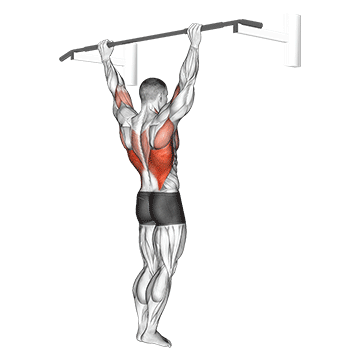
To perform the wide grip rear pull-up, start by positioning yourself under a pull-up bar. Reach up and grasp the bar with a wide overhand grip, your hands should be wider than shoulder-width apart.
Ensure your body is hanging straight down and your arms are fully extended. This is your starting position.
Engage your lats and pull your body upwards until your chest touches the bar. As you pull yourself up, try to pull your elbows down and back, squeezing your shoulder blades together.
Hold this position for a moment, then slowly lower yourself back to the starting position. Make sure to keep your body straight and avoid swinging or using momentum to pull yourself up.
Remember to breathe in as you lower yourself and breathe out as you pull yourself up.
Repeat the exercise for the desired number of repetitions.
This exercise primarily targets your lats, but also works your biceps, traps, and other muscles in your back and arms. It's a great exercise for building strength and muscle in your upper body.
Remember, it's important to use a weight that's challenging but allows you to perform the exercise with proper form. If you're unable to pull yourself up, you can use a pull-up assist machine or a resistance band to help you until you build up enough strength.
wide grip pull-up
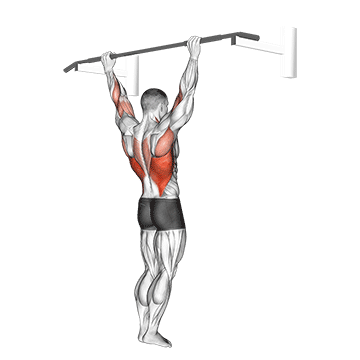
To perform a wide grip pull-up, start by standing under a pull-up bar. Reach up and grab the bar with your palms facing away from you. Your hands should be wider than shoulder-width apart, hence the name "wide grip".
Engage your core and keep your body straight. Pull your body up towards the bar, leading with your chest and keeping your elbows pointed out to the sides. Continue to pull yourself up until your chin is above the bar.
Hold this position for a moment, then slowly lower yourself back down to the starting position. Make sure to control your descent rather than just dropping back down. This is one repetition.
Remember to keep your body straight throughout the exercise and avoid swinging or using momentum to pull yourself up. The focus should be on using your lats to pull your body up and lower it back down.
For beginners, aim for 1-2 sets of 5-10 reps. As you get stronger, you can increase the number of sets and reps. If you find it too challenging, you can use a resistance band for assistance or perform negative pull-ups where you jump to the top position and slowly lower yourself down.
Always remember to warm up before starting the exercise and cool down afterwards. This will help prevent injury and improve your overall performance.
standing lateral stretch
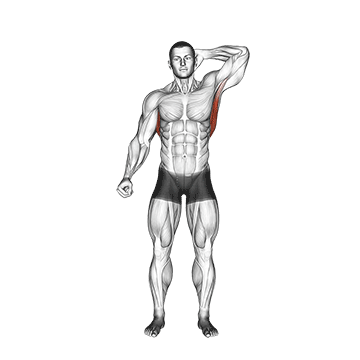
1. Stand up straight with your feet shoulder-width apart. This is your starting position.
2. Extend your arms overhead, interlocking your fingers.
3. Slowly bend your upper body to the right, keeping your arms straight and overhead. Ensure you are not leaning forward or backward.
4. Hold this position for a few seconds, feeling the stretch in your left lat muscle.
5. Slowly return to the starting position.
6. Repeat the same movement to the left side, this time stretching your right lat muscle.
7. Hold this position for a few seconds before returning to the starting position.
8. Repeat this exercise for the desired number of repetitions.
Remember to keep your movements slow and controlled, and focus on the stretch in your lats. Breathe deeply and evenly throughout the exercise.
side-to-side chin
1. Stand up straight with your feet shoulder-width apart. This is your starting position.
2. Slowly tilt your head to the right side, trying to touch your shoulder with your ear. Make sure you keep your shoulders down and relaxed during this movement. You should feel a stretch in the left side of your neck.
3. Hold this position for a few seconds, then slowly return your head to the center.
4. Repeat the same movement on the left side, tilting your head to the left and trying to touch your shoulder with your ear. You should feel a stretch in the right side of your neck.
5. Hold this position for a few seconds, then slowly return your head to the center.
6. Repeat this exercise for the desired number of repetitions.
7. Remember to keep your movements slow and controlled, and avoid any jerky or rapid movements to prevent injury.
Note: While this exercise can help to stretch and strengthen the neck muscles, it primarily targets the lats (latissimus dorsi), which are the large muscles in your back. By tilting your head from side to side, you're also engaging these muscles, helping to improve their flexibility and strength.
side lying floor stretch
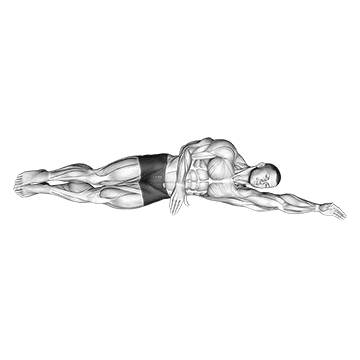
1. Start by finding a comfortable, flat surface where you have enough space to lie down on your side. This could be a yoga mat, carpet, or even a grassy outdoor area.
2. Lie down on your right side, extending your right arm straight out in front of you on the floor. Your legs should be straight and stacked on top of each other.
3. Bend your left arm at the elbow and place your left hand on the floor in front of your chest for support.
4. Slowly lift your left leg and bring it over your right leg, placing your left foot flat on the floor. Your knee should be bent at a 90-degree angle.
5. Reach your left arm up towards the ceiling and then slowly bend it at the elbow, reaching it towards your right hand. You should feel a stretch in your left lat muscle, which runs down the side of your back.
6. Hold this stretch for about 30 seconds, breathing deeply and trying to relax into the stretch.
7. Slowly release the stretch, bringing your left arm and leg back to their starting positions.
8. Roll over onto your left side and repeat the stretch with your right arm and leg.
9. Aim to complete this stretch 2-3 times on each side. Remember to keep your movements slow and controlled, and never push yourself to the point of pain. This exercise is about gently stretching and lengthening your lat muscles, not straining them.
shoulder grip pull-up
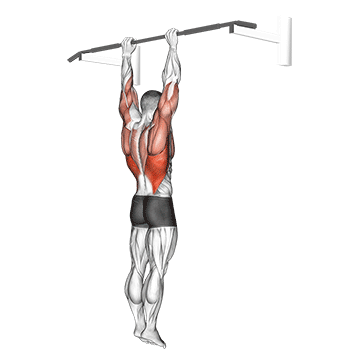
To perform the shoulder grip pull-up, start by finding a sturdy pull-up bar. Stand beneath the bar and reach up to grasp it with both hands. Your palms should be facing away from you and your hands should be slightly wider than shoulder-width apart. This is your starting position.
Engage your core and keep your body straight. Begin the exercise by pulling your body upwards towards the bar. As you pull yourself up, focus on using your lats (the large muscles in your back) rather than your arms. Continue pulling until your chin is above the bar.
Hold this position for a moment, then slowly lower yourself back down to the starting position. Be sure to keep your movements controlled and avoid swinging or using momentum to pull yourself up.
Repeat the exercise for the desired number of repetitions. Remember to breathe in as you lower yourself and breathe out as you pull yourself up.
This exercise can be challenging, especially for beginners. If you find it too difficult, you can modify it by using a pull-up assist machine or a resistance band. As your strength improves, you can gradually reduce the amount of assistance until you can perform the exercise using just your body weight.
seated lower back stretch
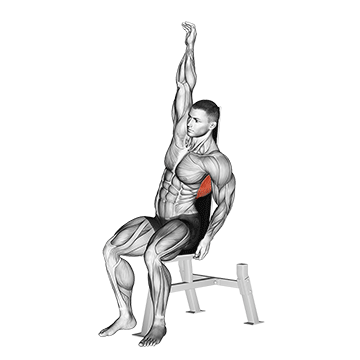
1. Begin by sitting on the floor with your legs extended out in front of you. Keep your back straight and your feet flexed.
2. Extend your arms out in front of you, keeping them shoulder-width apart.
3. Slowly bend forward at the waist, reaching your hands towards your toes. Keep your back straight and your head in a neutral position. You should feel a stretch in your lower back and lats.
4. Hold this position for 20-30 seconds, breathing deeply throughout.
5. Slowly return to the starting position.
6. Repeat this stretch 3-5 times, or as needed.
Remember to keep your movements slow and controlled, and never force a stretch. If you feel any pain, ease back on the stretch.
rocky pull-up pulldown
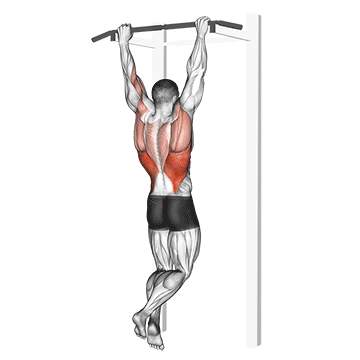
To perform the Rocky Pull-Up Pulldown, start by finding a sturdy pull-up bar. Stand beneath the bar and reach up to grasp it with both hands. Your palms should be facing forward and your hands should be slightly wider than shoulder-width apart. This is your starting position.
Engage your core and pull your body up towards the bar by driving your elbows down towards your hips. Continue to pull yourself up until your chin is above the bar. Ensure that you are not using your lower body or swinging to get yourself up, the movement should be controlled and come from your lats and arms.
Once your chin is above the bar, hold this position for a second. Then, instead of simply dropping back down, slowly lower your body back to the starting position. This is the "pulldown" part of the exercise. The slower you lower yourself, the more you engage your lats.
Repeat this movement for your desired number of repetitions. Remember to keep your movements controlled and to fully engage your lats throughout the exercise. If you find this exercise too challenging, you can modify it by using a resistance band for assistance.
reverse grip pull-up
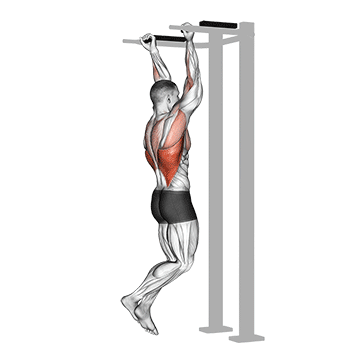
To perform the reverse grip pull-up, start by standing under a pull-up bar. Reach up and grab the bar with your palms facing towards you, this is the reverse grip. Your hands should be shoulder-width apart.
Engage your core and keep your body straight. Pull your body upwards until your chin is above the bar. Ensure that you are using your lats to pull your body up, not your arms. You should feel a squeeze in your lats at the top of the movement.
Slowly lower your body back down to the starting position. Make sure to do this part of the exercise slowly and controlled to get the most benefit.
Repeat this movement for your desired number of repetitions. Remember to keep your body straight and your core engaged throughout the entire exercise.
This exercise can be challenging, so don't be discouraged if you can't do many at first. With consistent practice, your strength will improve.
Remember, it's important to warm up before starting any exercise and cool down afterwards. Always consult with a fitness professional if you're unsure about how to perform an exercise.
rear pull-up
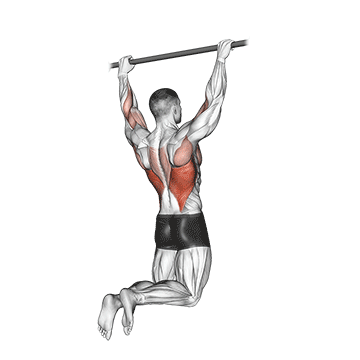
To perform a rear pull-up, start by finding a sturdy pull-up bar. Stand beneath the bar and reach up to grasp it with both hands. Your palms should be facing forward and your hands should be slightly wider than shoulder-width apart.
Engage your core and keep your body straight as you pull your body up towards the bar. As you pull yourself up, focus on using your lats, the large muscles in your back, rather than relying solely on your arms.
Continue to pull yourself up until your chest is level with the bar. At the top of the movement, your shoulder blades should be squeezed together and your elbows should be pointing down towards the floor.
Hold this position for a moment, then slowly lower yourself back down to the starting position. Be sure to keep your body straight and your core engaged as you lower yourself down.
Repeat this movement for your desired number of repetitions. Remember to keep your movements slow and controlled, focusing on the muscle contraction and not on swinging or using momentum to pull yourself up.
This exercise can be challenging, especially for beginners. If you find it too difficult to perform a rear pull-up using your body weight, you can use a pull-up assist machine or a resistance band to help you until you build up your strength.
pull-up
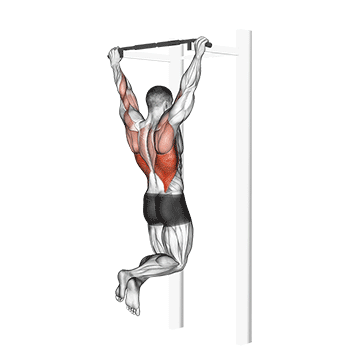
To perform a pull-up, start by standing under a pull-up bar. Reach up and grab the bar with your palms facing away from you. Your hands should be slightly wider than shoulder-width apart.
Engage your core and keep your body straight. This is your starting position.
Pull your body up towards the bar by squeezing your lats (the large muscles down your back). Keep your elbows close to your body as you pull up. Continue to pull until your chin is above the bar.
Hold this position for a second, then slowly lower your body back down to the starting position. Make sure to keep your body straight and your core engaged throughout the movement.
Repeat the exercise for the desired number of repetitions.
Remember, it's important to use your lats to pull your body up, not your arms. Your arms are just there to support you. If you're finding it difficult to perform a pull-up, you can use a pull-up assist machine or a resistance band to help you until you build up enough strength.
Always ensure to maintain proper form to avoid injury and to get the most out of the exercise.
pull up (neutral grip)
_Back_360.gif)
1. Stand under a pull-up bar. Reach up and grasp the bar with a neutral grip, meaning your palms should be facing each other. Your hands should be shoulder-width apart.
2. Hang from the bar with your arms fully extended. Your body should be straight, and your feet should not touch the ground. This is your starting position.
3. Begin the exercise by pulling your body upwards. Keep your elbows close to your body and continue to pull until your chin is level with or above the bar.
4. Hold this position for a moment, focusing on squeezing your lats (the muscles in your back) at the top of the movement.
5. Slowly lower your body back down to the starting position, ensuring that your movements are controlled and not too fast. This completes one repetition.
6. Aim to complete as many repetitions as you can while maintaining proper form. If you're a beginner, start with a few reps and gradually increase as your strength improves.
Remember to keep your body straight throughout the exercise and avoid swinging or using momentum to pull yourself up. This exercise should be performed using your lats, not your arm muscles.
one arm chin-up
To perform a one-arm chin-up, start by finding a sturdy pull-up bar. Stand beneath the bar and reach up with one arm, grasping the bar with a supinated (underhand) grip. Your palm should be facing towards you.
Engage your core and keep your body straight. Now, pull your body upwards using only the strength of your lats and the arm holding the bar. Try to bring your chin above the level of the bar.
Ensure that your body is not swinging or moving in an uncontrolled manner. This is crucial to prevent injury and to ensure that the targeted muscles are being worked effectively.
Once your chin is above the bar, hold the position for a second, then slowly lower your body back down to the starting position. This completes one repetition.
Remember to switch arms and repeat the exercise to ensure balanced strength development.
Note: The one-arm chin-up is an advanced exercise and requires a significant amount of upper body strength. If you're unable to perform it, you can start with regular chin-ups or assisted one-arm chin-ups and gradually build up your strength.
one arm against wall
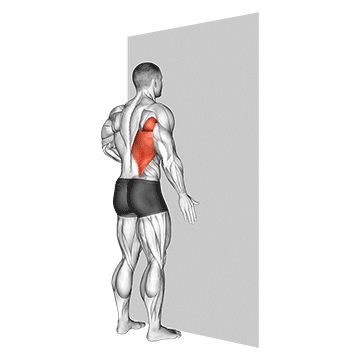
To perform the one arm against wall exercise, start by standing up straight, facing a wall. Your feet should be shoulder-width apart for balance.
Choose one arm to start with. Extend it straight out in front of you and place your palm flat against the wall, fingers pointing upwards. Your arm should be at shoulder height.
Lean into the wall, pressing your palm firmly against it. Keep your other arm by your side or place it on your hip.
Now, slowly slide your hand up the wall, stretching your lat muscle. You should feel a stretch down the side of your torso and into your back.
Hold this position for about 20-30 seconds, then slowly lower your arm back to the starting position.
Switch arms and repeat the exercise.
Remember to keep your body straight and your core engaged throughout the exercise.
This exercise can be done as many times as comfortable, but aim for at least 3 sets of 10-15 repetitions on each side.
Remember to breathe normally throughout the exercise and to stretch both sides equally to avoid muscle imbalance.
This exercise is great for stretching and strengthening your lats using just your body weight.
muscle-up (on vertical bar)
1. Start by standing directly under a vertical bar. Reach up and grasp the bar with an overhand grip, hands slightly wider than shoulder-width apart. This is your starting position.
2. Engage your core and pull your body up towards the bar by driving your elbows down towards your hips. Keep your body as close to the bar as possible.
3. As your chin reaches the level of the bar, quickly transition your hands from a pull-up position to a dip position. This is done by rolling your wrists over the bar, so your palms are facing down.
4. Push your body upwards until your arms are fully extended and your chest is above the bar. Your body should be above the bar with your hips directly under it.
5. Lower yourself back down to the starting position in a controlled manner. This completes one repetition.
6. Repeat the exercise for the desired number of repetitions.
Remember to keep your movements controlled and fluid throughout the exercise. Avoid using momentum to pull yourself up, as this can lead to injury. Instead, focus on using your lats and other upper body muscles to complete the movement.
muscle up
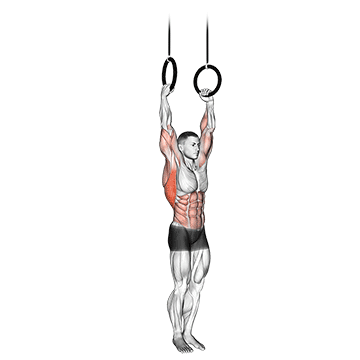
1. Start by standing directly under a pull-up bar. Reach up and grasp the bar with an overhand grip, hands slightly wider than shoulder-width apart. This is your starting position.
2. Begin the exercise by performing a pull-up. Use your lats to pull your body upwards. Keep your core engaged and your body straight.
3. As you reach the top of the pull-up, quickly transition into a dip by driving your elbows down and pushing your chest up towards the bar. This is the most challenging part of the muscle up, known as the transition.
4. Once your chest is above the bar, push your body upwards until your arms are fully extended. You should now be above the bar, in a dip position.
5. Lower yourself back down to the starting position in a controlled manner, completing one rep.
6. Repeat the exercise for the desired number of reps.
Remember to keep your movements controlled and fluid throughout the exercise. The muscle up is a complex movement that requires strength, coordination, and technique. It may take some time to master, so be patient with yourself and keep practicing.
mixed grip chin-up
To perform the mixed grip chin-up, start by finding a sturdy pull-up bar. Stand beneath the bar and reach up to grasp it. One hand should be in an underhand grip (palm facing towards you) and the other in an overhand grip (palm facing away from you). This is the mixed grip position.
Ensure your hands are slightly wider than shoulder-width apart. Hang from the bar with your arms fully extended. Your body should be straight, and your feet should not touch the ground. This is your starting position.
Begin the exercise by pulling your body upwards towards the bar. Keep your elbows close to your body and squeeze your shoulder blades together. Continue to pull yourself up until your chin is above the bar.
Hold this position for a moment, then slowly lower yourself back down to the starting position. Make sure to keep your body straight and avoid swinging or using momentum to pull yourself up.
Repeat the exercise for the desired number of repetitions. Remember to breathe in as you lower yourself and breathe out as you pull yourself up.
For balanced muscle development, switch the position of your hands (which one is overhand and which one is underhand) each set or workout. This will ensure both sides of your lats get an equal workout.
l-pull-up
To perform the L-Pull-Up, follow these steps:
1. Start by finding a sturdy pull-up bar that can support your body weight. Ensure your hands are dry to prevent slipping.
2. Stand beneath the pull-up bar and reach up to grasp it with both hands. Your grip should be slightly wider than shoulder-width apart, palms facing away from you. This is your starting position.
3. Lift your legs and straighten them out in front of you until they are parallel with the ground, forming an 'L' shape with your body. Engage your core to maintain this position throughout the exercise.
4. Pull your body up towards the bar by driving your elbows down towards your hips. Continue to pull until your chin is above the bar. Ensure to keep your legs and torso stationary to maintain the 'L' shape.
5. Hold this position for a second, then slowly lower your body back down to the starting position. Make sure to keep your legs raised and straight throughout the movement.
6. Repeat the exercise for the desired number of repetitions.
Remember to breathe in as you lower your body and breathe out as you pull yourself up. This exercise can be challenging, so start with a few repetitions and gradually increase as your strength improves.
kneeling lat stretch
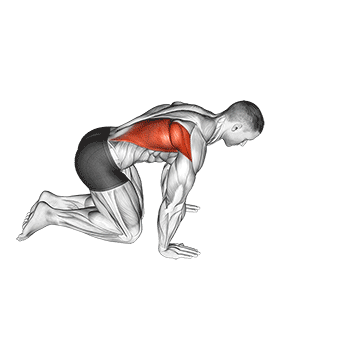
1. Start by kneeling on the floor or a mat. Your knees should be hip-width apart and your feet should be together behind you.
2. Sit back on your heels and reach your arms out in front of you, keeping them shoulder-width apart.
3. Lower your chest towards the floor as far as you can while keeping your arms extended. You should feel a stretch in your lats, which are the muscles on the sides of your back.
4. Hold this position for about 30 seconds, then slowly return to the starting position.
5. Repeat this exercise for the desired number of repetitions. Remember to keep your movements slow and controlled, and to breathe deeply throughout the exercise.
kipping muscle up
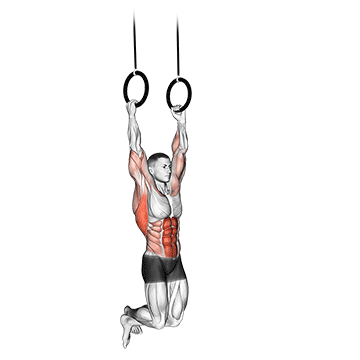
To perform a Kipping Muscle Up, follow these steps:
1. Start by hanging on a pull-up bar with your hands slightly wider than shoulder-width apart. Your palms should be facing away from you. This is your starting position.
2. Initiate a swing by pushing and pulling on the bar with your shoulders. This is known as the 'kip'. Your body should move in a forward and backward motion, not up and down.
3. As you swing forward, pull your knees up towards your chest. This will help generate momentum for the next part of the exercise.
4. At the peak of your swing, explosively pull your body up towards the bar. Use the momentum from your kip to help you.
5. As your chest reaches the bar, quickly transition your hands from a pull-up grip to a dip grip. This means rotating your wrists so your palms are now facing towards you.
6. Push your body up until your arms are fully extended. You should now be above the bar, in a dip position.
7. Lower yourself back down to the starting position and repeat the exercise.
Remember to engage your lats throughout the exercise, especially during the pull-up and dip phases. Also, ensure you maintain control during the kip to avoid injury. This exercise requires a lot of strength and coordination, so it may take some time to master.
gironda sternum chin
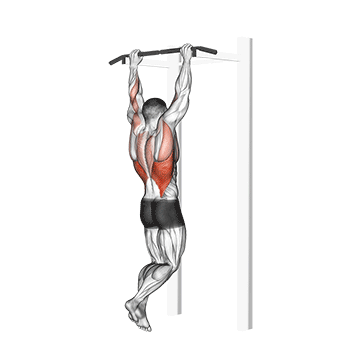
1. Stand upright and position yourself under a pull-up bar. Your feet should be shoulder-width apart.
2. Reach up and grip the bar with your palms facing towards you (underhand grip). Your hands should be slightly wider than shoulder-width apart.
3. Bend your knees slightly and cross your ankles behind you. This is your starting position.
4. Begin the exercise by pulling your body upwards towards the bar. As you pull up, lean your head back away from the bar and arch your spine throughout the movement.
5. Continue to pull yourself up until your chest touches the bar, or gets as close as possible. Your elbows should be pointing down towards the floor and slightly behind you.
6. Hold this position for a moment, squeezing your lats at the top of the movement.
7. Slowly lower your body back down to the starting position, maintaining control and not allowing your body to swing.
8. Repeat the exercise for the desired number of repetitions.
Remember to keep your movements smooth and controlled, focusing on the muscle contraction and not on swinging your body up. The key to this exercise is the arching of the back, which helps to target the lats more effectively.
close grip chin-up
To perform a close grip chin-up, start by standing under a chin-up bar. Reach up and grab the bar with your palms facing towards you (supinated grip) and your hands positioned closer than shoulder-width apart. This is your starting position.
Engage your core and keep your body straight. Pull your body upwards towards the bar, leading with your chest and keeping your elbows close to your body. Continue this upward movement until your chin is level with or above the bar.
Pause at the top of the movement, then slowly lower your body back down to the starting position. Ensure that you fully extend your arms at the bottom of the movement to engage your lats effectively.
Remember to breathe in as you lower your body and breathe out as you pull yourself up. Repeat the exercise for the desired number of repetitions.
Ensure that you maintain control throughout the movement, avoiding any swinging or jerking motions. This exercise can be challenging, so don't be discouraged if you can only do a few reps at first. With consistent practice, your strength will improve.
chin-up
To perform a chin-up, start by standing directly under a sturdy horizontal bar that is high enough for you to fully extend your arms overhead. Reach up and grip the bar with your palms facing towards you (underhand grip) and your hands shoulder-width apart.
Engage your core and keep your body straight. Pull your shoulder blades back and down, bend your elbows, and lift your body up towards the bar. Continue to pull yourself up until your chin is above the bar.
Pause at the top of the movement, then slowly lower your body back down to the starting position, fully extending your arms. Ensure that you maintain control throughout the movement, avoiding any sudden drops.
This exercise primarily targets your lats, but also works your biceps and middle back. Remember to breathe in as you lower your body and breathe out as you lift yourself up. Aim for as many repetitions as you can manage with good form.
If you find it challenging to perform a chin-up, you can use an assisted chin-up machine or a resistance band to help you lift your body weight. As you get stronger, you can gradually reduce the assistance until you can perform a chin-up using just your body weight.
bench pull-ups
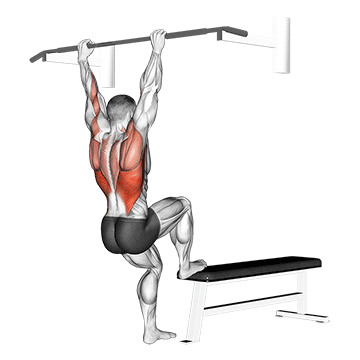
To perform bench pull-ups, start by finding a sturdy bench or similar platform that can support your body weight.
1. Lie down on your back under the bench. Position yourself so that your chest is directly under the edge of the bench.
2. Reach up and grip the edge of the bench with both hands. Your palms should be facing towards you in an underhand grip.
3. Keep your feet flat on the ground and your knees bent at a 90-degree angle.
4. Pull your body up towards the bench using your lats, the muscles in your back. Your elbows should be close to your body as you pull up.
5. Lift your body until your chest touches the bench.
6. Lower your body back down in a controlled manner until your arms are fully extended.
7. Repeat this movement for your desired number of repetitions.
Remember to keep your core engaged throughout the exercise to protect your lower back. Also, ensure that you are pulling with your back muscles and not just your arms. This exercise is a great way to target your lats using just your body weight.
back pec stretch
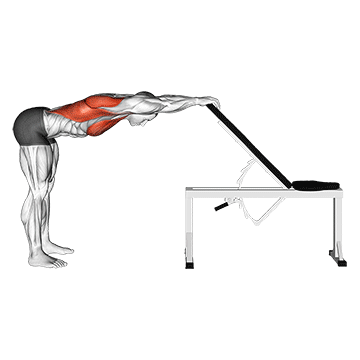
To perform the back pec stretch, begin by standing tall with your feet shoulder-width apart. This exercise requires no equipment, just your body weight.
1. Extend your arms out to your sides, parallel to the floor, and bend your elbows to a 90-degree angle. Your palms should be facing forward.
2. Slowly pull your elbows back, squeezing your shoulder blades together. You should feel a stretch in your chest and lats.
3. Hold this position for about 20-30 seconds, breathing deeply throughout.
4. Release and return to the starting position.
5. Repeat this stretch 3-5 times, or as needed.
Remember to keep your spine neutral and your shoulders down and back throughout the exercise. This will help to ensure that you're targeting your lats effectively.
archer pull up
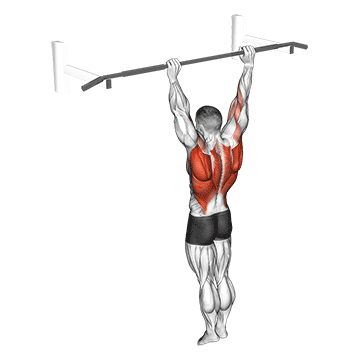
To perform the Archer Pull Up, start by finding a sturdy pull-up bar. Stand beneath the bar and reach up to grasp it with both hands. Your grip should be wider than shoulder-width apart, with your palms facing away from you. This is your starting position.
Next, pull your body up towards the bar, but instead of pulling straight up as you would in a traditional pull-up, shift your body weight to one side. As you pull up, one arm should bend and do most of the work (like pulling a bowstring), while the other arm remains straight.
Try to get your chin above the bar on the side of the working arm. The straight arm should be fully extended and is only used for balance and slight support.
Lower yourself back down in a controlled manner, extending the working arm and shifting your body weight back to the center.
Repeat the movement, this time shifting your weight to the other side and pulling up with the other arm. This counts as one rep.
Aim for as many reps as you can manage with good form. Remember to engage your core throughout the exercise and avoid swinging or using momentum to pull yourself up.
This exercise primarily targets the lats, but also works the biceps, triceps, and shoulders. It's a great exercise for developing unilateral strength and improving overall upper body strength.
No tags for this post.
